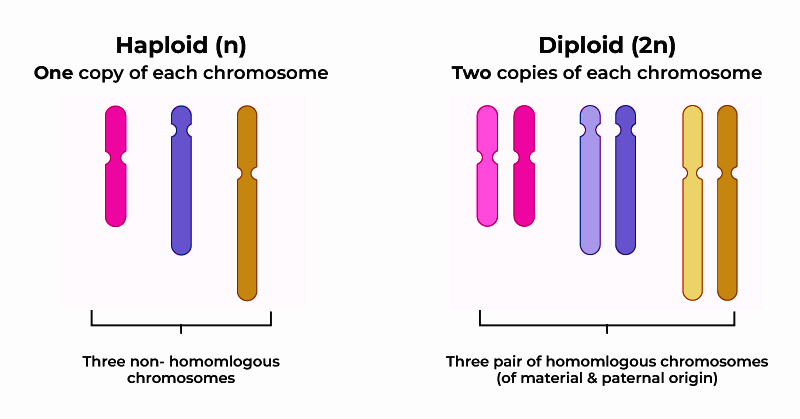
Haploid: The ploidy of a cell refers to the number of complete sets of chromosomes it contains. These chromosome sets are inherited from both the paternal and maternal copies. Based on the number of chromosome sets, cells can be classified into three categories: haploid, diploid, and polyploid. Haploid cells contain one set of chromosomes, diploid cells contain two sets, and polyploid cells have more than two complete sets of chromosomes.
Furthermore, ploidy can be categorized into two types based on changes in the number of chromosomes: euploidy and aneuploidy. Euploidy refers to the presence of an exact multiple of the haploid number of chromosomes, while aneuploidy refers to an abnormal number of chromosomes that is not an exact multiple of the haploid number. This article will detail NEET Biology Notes on Haploid cell, chromosomes, haploid number, and examples.
What is Haploid Cell?
Haploid refers to a cell that possesses a single set of chromosomes. This term is often used to describe the chromosome number in egg or sperm cells, known as gametes. In humans, gametes are haploid cells containing 23 chromosomes, each representing one chromosome from a pair found in diploid cells. The number of chromosomes in a single set is denoted as n, also referred to as the haploid number. In humans, n equals 23.
Gametes have half the number of chromosomes found in normal diploid cells of the body, known as somatic cells. Haploid gametes are generated through meiosis, a type of cell division that reduces the chromosome number by half in the parent diploid cell. Certain organisms, such as algae, exhibit haploid stages in their life cycle. Other organisms, such as male ants, remain haploid throughout their entire life cycle.

Sexual Reproduction in Flowering Plants
Haploid Number
Haploid number, symbolized as n , represents the number of chromosomes in a single set within an organism's genome. A haploid cell contains only one copy of each chromosome, for a total of n chromosomes. Typically, haploid cells are gametes like sperm and egg cells.
On the other hand, somatic cells are diploid, meaning they have two sets of chromosomes, one from each parent. In a diploid cell, 2n represents the total number of chromosomes. During sexual reproduction, the fusion of two gametes (sperm and egg) produces a diploid zygote with the full complement of chromosomes (2n).
Haploid number is a fundamental concept in genetics that is essential for understanding sexual reproduction and inheritance. It ensures genetic diversity in offspring through the process of meiosis, which creates gametes, shuffles chromosomes, and generates unique gene combinations for the next generation.
Haploid Chromosome
A haploid chromosome is a single chromosome from a complete set within a cell. Cells are categorized by the number of chromosome sets they possess. The haploid chromosome overview is as follows:
Haploid (n): These cells have one set of chromosomes and are typically sex cells or gametes (sperm and egg cells) in sexually reproduce organisms.
Diploid (2n): These cells have two sets of chromosomes, one set inherited from each parent. These are the somatic cells that constitute the body of an organism.
In humans, for example, somatic cells are diploid, containing 46 chromosomes (23 pairs). In contrast, sperm and egg cells are haploid, each containing 23 chromosomes (one from each pair).
Structural Organisation in Animals
Importance of Haploid Chromosomes
Haploid chromosomes play a vital role in sexual reproduction. During fertilization, sperm and egg cells merge, combining their haploid sets of chromosomes to form a new diploid zygote (fertilized egg). This zygote then undergoes cell division (mitosis) to develop into a multicellular organism. The importance of haploid chromosomes is as follows:
- Genetic Variation: Since sperm and egg cells contain different combinations of chromosomes due to meiosis (the process that shuffles genes), the fusion of these haploid cells during fertilization leads to genetic diversity in offspring.
- Sexual Reproduction: Haploid gametes are essential for sexual reproduction, allowing organisms to produce offspring with a mix of genetic material from two parents.
Haploid Gametophyte
The gametophyte is a multicellular organism that develops from a haploid spore. It represents the sexual phase in the plant life cycle and serves as the haploid generation, meaning it possesses only one set of chromosomes (denoted as ‘n’). Gametophytes produce gametes, which are haploid sex cells responsible for fertilization. Key characteristics of a haploid gametophyte is as follows:
- Haploid: Contains one set of chromosomes (n).
- Multicellular: Composed of many cells.
- Sexual phase: Produces gametes (sex cells) via mitosis, a type of cell division resulting in genetically identical daughter cells.
- Develops from spores: Spores are haploid reproductive units formed by meiosis in the sporophyte generation.
The life cycle of plants with alternation of generations typically involves the following stages:
- Sporophyte: The diploid (2n) sporophyte produces spores through meiosis.
- Spore dispersal: Spores are released and dispersed by wind, water, or animals.
- Gametophyte development: Spores germinate and develop into multicellular, haploid gametophytes.
- Gamete production: Gametophytes produce sperm and eggs through mitosis.
- Fertilization : Sperm fertilizes the egg, forming a diploid zygote (2n).
- Sporophyte development: The zygote develops into a new sporophyte generation.
The dominance of sporophyte and gametophyte generations varies greatly between plant groups. In mosses, the gametophyte is the dominant generation, with the sporophyte relying on it for nutrition. In contrast, flowering plants exhibit a dominant sporophyte generation, with the gametophyte being notably reduced in size and complexity.
| Important NEET Biology Notes | ||
|---|---|---|
| Selaginella | Embryo | Malvaceae |
| Pinus | Polyembryony | Volvox |
Haploid Cells in Human
In humans, haploid cells refer to sperm and egg cells, also known as gametes. These cells contain only one set of 23 chromosomes. This is distinct from most other cells in the body, known as somatic cells, which possess two sets of chromosomes (one from each parent), totalling 46 chromosomes.
Haploid cells are produced through a specialized type of cell division called meiosis. Meiosis reduces the chromosome count by half compared to the original cell. This reduction is crucial for sexual reproduction because when a sperm fertilizes an egg, the resulting zygote will inherit the correct number of chromosomes (46) - one set from each parent.
| Important NEET Biology Notes | ||
|---|---|---|
| Chara | Funaria | Apomixis |
| Rhizopus | Spirogyra | Bacteriophage |
Haploid Cells in Plants
Haploid cells in plants have only one set of chromosomes, denoted as the gametophytic number (n), compared to diploid cells which have two sets (2n) of chromosomes.
Haploid plants are important for breeding programs because they can produce homozygous lines. These plants are typically derived from either male or female gametic cells. There are two main types of haploids:
- Monoploids (monohaploids): These have half the number of chromosomes as a diploid species, such as maize and barley.
- Polyhaploids: These haploids have half the number of chromosomes as a polyploid species, for example, wheat and potato.
In humans, haploid cells are produced through meiosis, a type of cell division where a single diploid parent cell divides to produce four non-identical haploid daughter cells. Meiosis is essential for producing gametes and is a critical step in sexual reproduction.
Haploid Cell Examples
Haploid cells are cells that contain only one set of chromosomes. Here are some examples of haploid cells:
- Gametes in Humans: Most cells in your body are diploid, except for gametes. Gametes, like eggs and sperm, are produced by your parents, each carrying a single set of chromosomes. When these haploid gametes combine during fertilization, they form the first diploid cell of your body. The reproductive organs have a special meiosis process to produce these haploid gametes instead of the usual cell division (mitosis).
- Drones in Insects: In many insect species, including bees, there is a unique sex determination system based on ploidy. The queen bee and worker bees are diploid, while the drones are haploid. Drones have the role of transporting sperm to other colonies.
- Spores and Pollen: Spores (found in fungi, algae, and plants) and pollen (found in male plants) are also examples of haploid cells.
These haploid cells are vital in sexual reproduction as they contribute to genetic diversity and adaptation.
Haploid vs Diploid
The primary distinction between haploid and diploid cells is their chromosome set numbers. Haploid cells have a single set of chromosomes, whereas diploid cells have two. This difference is important for sexual reproduction because it ensures offspring have the correct chromosome number.
Haploid Cells:
- Haploid cells contain only one set of chromosomes (n).
- They are formed through the process of meiosis and exhibit genetic diversity.
- In most eukaryotic organisms, sex cells or gametes are haploid.
- Fusion of haploid cells from male and female during fertilization results in the formation of a diploid cell.
Diploid Cells:
- Diploid cells contain two complete sets of chromosomes (2n).
- Each set of chromosomes originates from one parent.
- Most cells in the human body are diploid, except for gametes (sperm and egg cells) which are haploid.
- They are produced by the process of mitosis.
- Somatic cells in humans are examples of diploid cells.
Physics Wallah provides the NEET Online Coaching to help students prepare for the exam. PW connects students with expert teachers who can explain complex concepts. Students are provided with materials, practice questions, and practice tests to assist them in effectively studying and identifying areas for improvement. Enroll Now!
| NEET Exam Important Links | |
|---|---|
| NEET Biology Syllabus | NEET Biology Diagrams |
| NEET Biology MCQ | NEET Biology Chapter wise Weightage |
| NEET Biology Notes | NEET Previous Year Question papers |
Haploid FAQs
What are haploid and diploid?
Are humans haploid or diploid?
Is egg haploid or diploid?
What is haploid and its example?
Is haploid n or 2n?










